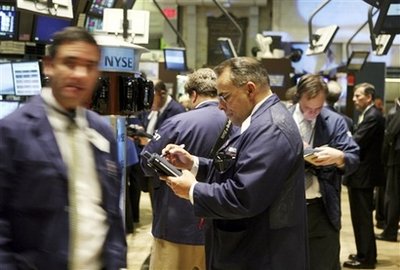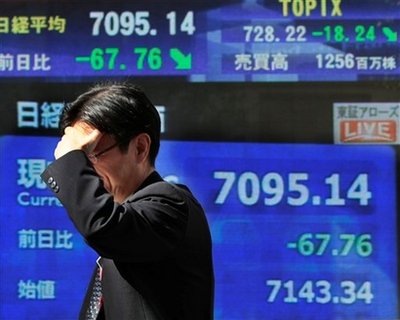Oct. 29 (Bloomberg) -- Richard Burnett's lumber company had started loading wood onto ships heading for China. More was en route to the docks. It was all part of an order that would fill 100 40-foot cargo containers.
Then Burnett got a call from his buyer at Shanghai VIVA Wood Products Co. The deal was dead. He told Burnett, president of Cross Creek Sales LLC in Augusta, Georgia, he couldn't get a letter of credit to guarantee payment for at least six months.
``It was like a spigot got cut off,'' Burnett said, recounting the transaction that fell apart in July. The inability of buyers in China and Vietnam to get letters of credit has cost his company as much as $4 million this year, a third of projected revenue, forcing him to lay off 15 of 35 employees, he said.
Suppliers of oil, coal, grains and consumer products from Chicago to Mumbai are losing sales as the credit crisis spreads beyond financial institutions, and banks refuse financing or increase the fees for buyers. Coupled with declining demand, the credit squeeze is threatening international trade, one of the lone bright spots in the global economy.
``It's like standing on a beach watching a tsunami, knowing that it's coming,'' said Scott Stevenson, manager of the International Finance Corp.'s Global Trade Finance Program. IFC is the World Bank's private lending arm.
Emerging markets such as Brazil, Vietnam and South Africa are particularly vulnerable because buyers have more trouble proving their financial strength. The slowdown is also damaging the U.S., the world's largest economy, where exports accounted for almost two-thirds of the 2.1 percent growth in gross domestic product in the 12 months through June, according to the U.S. Trade Representative's office.
Shipping Rates Fall
Another sign of trouble: The Baltic Dry Index, a measure of commodity shipping costs that banks watch as an economic indicator, fell below 1,000 yesterday for the first time in six years, dropping it 89 percent for the year.
Global trade volumes may sink next year, their first decrease since 1982, according to Andrew Burns, a lead economist at the World Bank. While there is still uncertainty over future prospects, trade may contract by as much as 2 percent, after annual increases of 5 percent to 10 percent over the past decade.
``We only see this kind of shock when we have outbreaks of war, or maybe the oil shocks of the 1970s,'' said Kjetil Sjuve, a commodities shipbroker at Lorentzen & Stemoco AS in Oslo. ``This lack of credit was a shock to the entire economy. We were hit second after the banks.''
Letters of Credit
Of the $13.6 trillion of goods traded worldwide, 90 percent rely on letters of credit or related forms of financing and guarantees such as trade credit insurance, according to the Geneva-based World Trade Organization.
Letters of credit are centuries-old instruments that allow far-flung partners to complete large transactions. An importing company gets its bank to issue the letter, guaranteeing payment for a delivery. That bank provides the letter to the exporter's bank, which then guarantees payment to the exporting company.
The system breaks down when banks don't trust one another and are unwilling to accept a letter of credit as proof that payment is coming.
From 2000 through last year, the use of letters of credit declined to about 10 percent of global trade transactions, the IFC's Stevenson said. Over the past six months, they began ``roaring back into fashion'' as sellers sought to guarantee payments from buyers they no longer trusted, he said. At the same time, liquidity problems caused banks to increase charges.
Rates Rise
The cost of a letter of credit has tripled for buyers in China and Turkey and doubled for Pakistan, Argentina and Bangladesh, said Uwe Noll, director of country risk sales at Deutsche Bank AG. Banks are now charging 1.5 percent of the value of the transaction for credit guarantees for some Chinese transactions, bankers say.
``The whole global trade production line relies on letters of credit,'' Matt Robinson, an analyst at Moody's Economy.com wrote in an Oct. 23 report. ``No letters of credit, no transactions -- and no transactions mean no international trade.''
The evidence is piling up in the world's ports.
An Iranian oil tanker able to carry enough crude oil to supply Ireland for five days arrived at the Turkish port of Ceyhan on Oct. 6. Then she waited eight days before the company that hired her was able to secure a letter of credit that was acceptable to Iraq, the country selling the cargo, according to two people involved in the loading and unloading of the oil.
`Crisis Situation'
Mumbai-based Essar Shipping Ports & Logistics Ltd. couldn't buy equipment used to handle bulk materials at ports when the Chinese supplier wasn't able get a letter of credit from an Indian state-owned bank accepted in China, said V. Ashok, Essar's executive director.
``This is absolutely a crisis situation here,'' Ashok said. ``If you don't discount LCs, how will you do business? Business around the world is done on LCs, not cash. It's all jammed.''
In Chicago, C1 Resources is holding up 1 million metric tons of cement valued at as much as $150 million, because an African customer can't secure a letter of credit, said Chief Operating Officer Rob Risner. The order was placed Sept. 10 for shipment to Nigeria, Cameroon and Angola and the customer is still seeking a line of credit, Risner said.
Burnett, of Cross Creek, said the demise of his deals with Asian buyers also reflects the weakness of the U.S. economy, including a slowdown in construction that has reduced demand for the wood products companies such as Shanghai VIVA make.
Liu Jian Jun, manager of Shanghai VIVA, said weak demand in the U.S. and elsewhere killed the deal with Cross Creek, not access to credit.
Small Business Hurt
James Morrison, president of the Small Business Exporters Association in Washington, polled 1,000 of his members this month on the impact tight credit is having on their ability to trade. By a margin of six to one, companies that had tried to get export financing recently said they faced ``unusual difficulties.''
A few said their banks had told them the terms of existing credit facilities had to be reworked and the companies would have to provide more principal, Morrison said.
The same is true in Brazil. An Oct. 23 report from the country's Confederacao Nacional das Industrias, which represents 27 industry groups and 7,000 trade associations, found that Brazilian companies of all size are losing access to credit.
``To make exports feasible, you need funding and this has virtually dried up in the last weeks,'' said Flavio Castelo Branco, chief economist for the group.
`More Cautious'
Policymakers are responding. Pascal Lamy, head of the WTO, has called a meeting of trade officials for Nov. 12 in Geneva to discuss how to get more credit to exporters in poor nations. The organization has invited heads of the largest development banks as well as representatives from Citigroup Inc., JPMorgan Chase & Co. and other commercial banks.
The World Bank has added $500 million to the $1 billion it was already using to guarantee export financing. The U.S. Export- Import Bank, a government-chartered entity that helps finance exports, is gearing up to provide more guarantees, said Jeffrey Abramson, vice president for trade finance.
Dominic Ng, chief executive officer of Pasadena, California- based East-West Bancorp Inc., the biggest lender serving the Chinese community in the U.S., said his bank this year has reduced the number of letters of credit issued for the first time. It is providing about 10 percent fewer letters, after annual increases of 10 percent to 20 percent in the past decade.
``We've become more cautious,'' Ng said, blaming the retrenchment on a decline in the number of credit-worthy customers. Bank bailouts funded by the U.S. and other governments have begun to ease liquidity problems.
``But we still have credit issues,'' he said. ``And they are going to get worse, not better, because the economy is getting worse.''
To contact the reporters for this story: Michael Janofsky in Los Angeles at mjanofsky@bloomberg.net; Mark Drajem in Washington at mdrajem@bloomberg.net; Alaric Nightingale in London at anightingal1@bloomberg.net

















